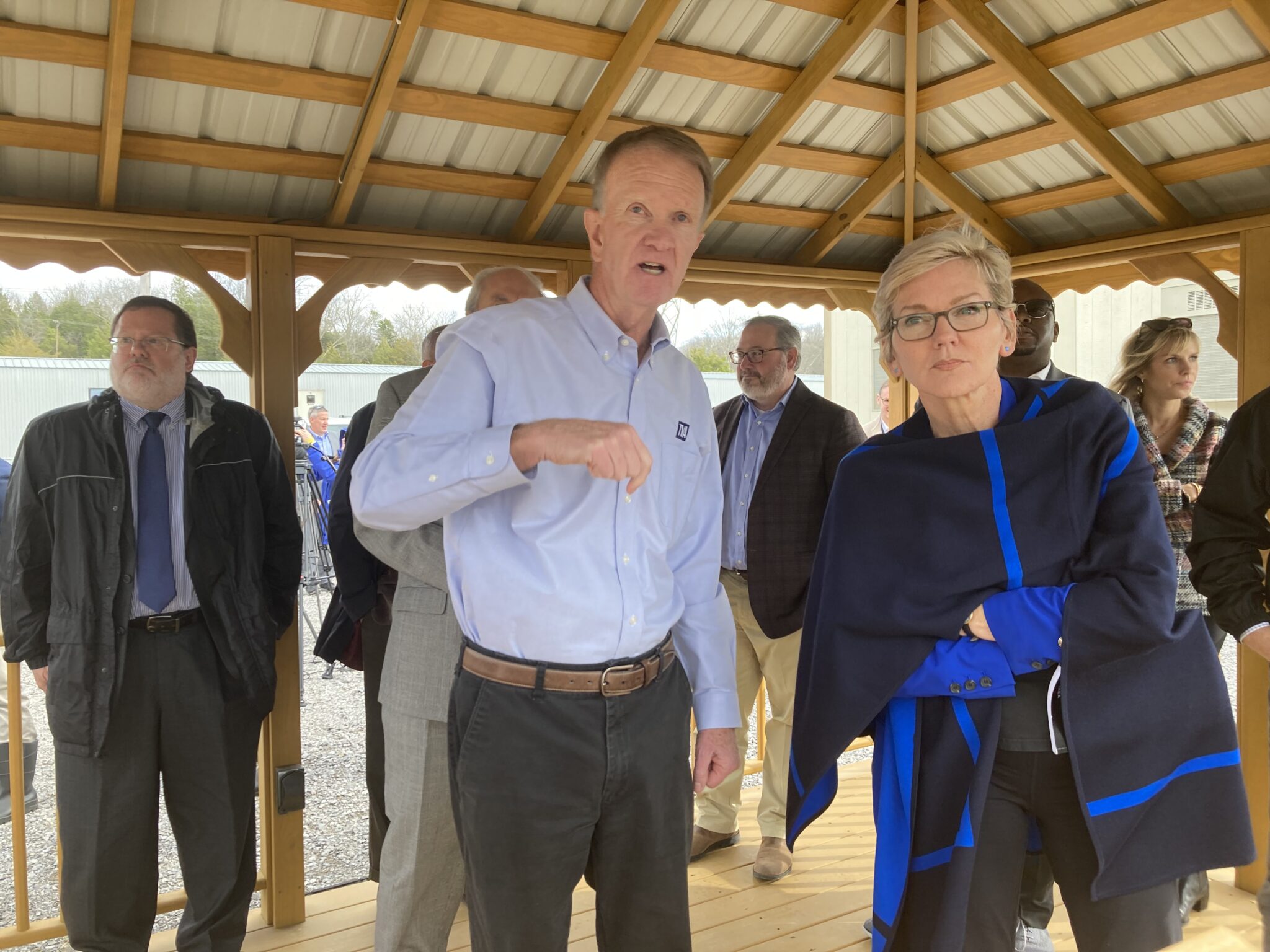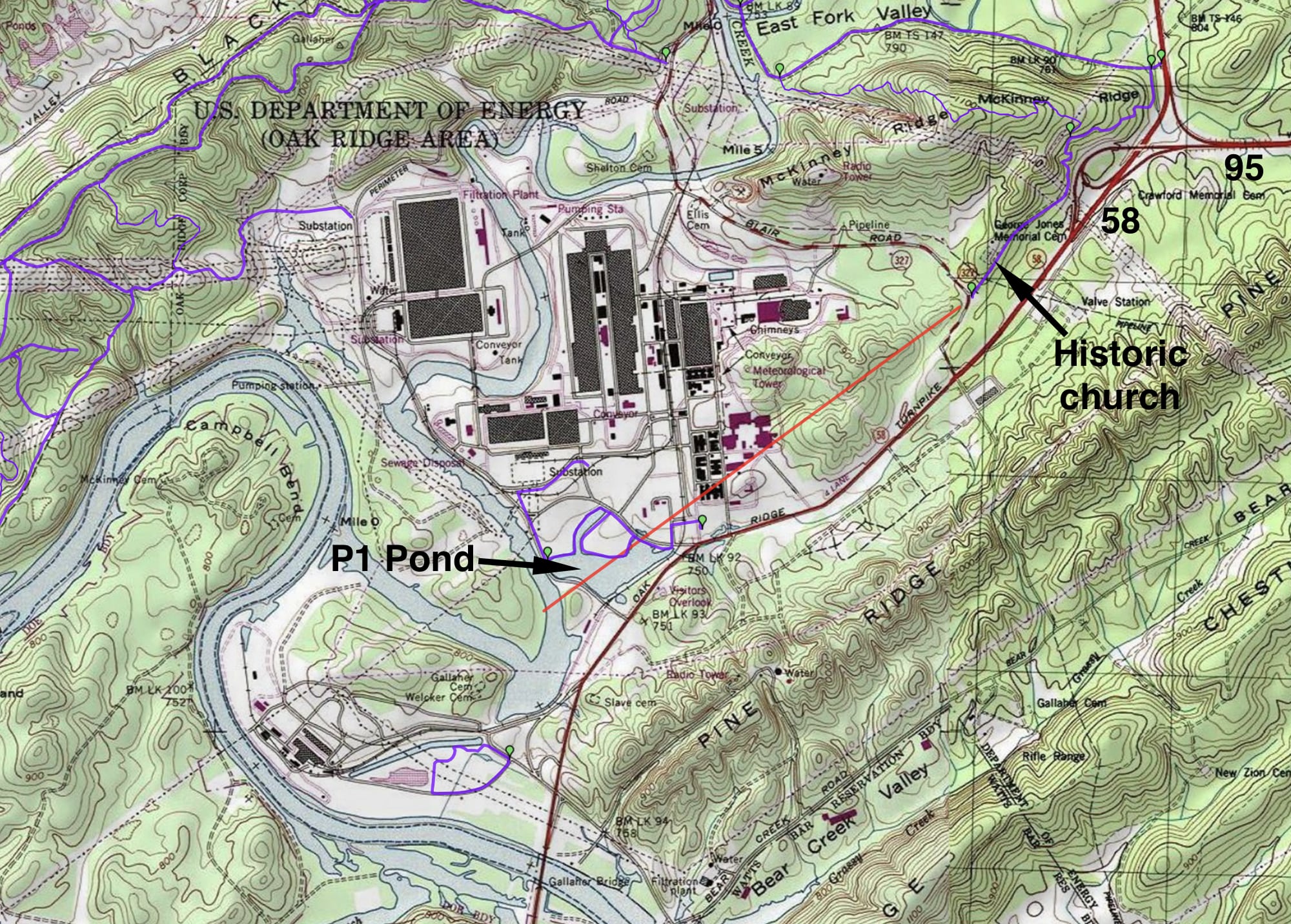Voices (103)
SELC Celebrates the 2024 Reed Environmental Writing Award winners
Written by Southern Environmental Law Center
The Southern Environmental Law Center congratulates this year’s Reed Environmental Writing Award winners — Emily Strasser, David Folkenflik, Mario Ariza, and Miranda Green — who all demonstrate the power of writing to capture some of the most important environmental issues facing Southern communities.
Emily Strasser receives the Reed Award for “Half-Life of a Secret: Reckoning with a Hidden History.” In the book, Strasser examines the toxic legacy of Oak Ridge, Tennessee, one of three secret cities constructed by the Manhattan Project for developing the first atomic bomb. She exposes a suppressed history that forever impacted her family, a community, the nation, and the world.
David Folkenflik with NPR, and Mario Ariza and Miranda Green with Floodlight, receive the Reed Award for their story, “In the Southeast, power company money flows to news sites that attack their critics.” Their investigation digs into a consulting firm working on behalf of electric utility giants in Alabama and Florida. The team uncovers how money flows from the firm to influence local news sites to push the utilities’ agendas and attack their critics.
Everyone is invited to join for a celebration honoring the winners and the 30th anniversary of the Reed Award in person or virtually on March 22 at 5:00 p.m. The in-person event will take place at the CODE Building, located at 225 West Water Street on the Downtown Mall in Charlottesville, VA.
- southern environmental law center
- emily strasser
- david folkenflik
- mario ariza
- miranda green
- manhattan project
- halflife of a secret: reckoning with a hidden history
- floodlight: the environmental news collaborative
- southeast power companies
- reed award
- national public radio
- npr
- virginia festival of the book
Join policy makers, experts and lawyers to discuss Southern Appalachian enviro and legal issues

KNOXVILLE — The 15th Appalachian Public Interest and Environmental Law Conference (APIEL) is set for Oct. 5 at The University of Tennessee College of Law.
APIEL is an annual gathering of lawyers, scientists, students, and members of the general public to discuss environmental issues and happenings in Appalachia, public policy, and grassroots initiatives.
The purpose is to create dialogue between lawyers, activists, and scientists on the local areas of need and foster engagement within the community to be forces of change in the legal realm.
APIEL is a conference of the student-run Environmental Law Organization (ELO) at the University of Tennessee College of Law. ELO is not directly affiliated with the University of Tennesse or any particular non-profit organization. It is dedicated to providing students and attorneys with learning opportunities and leadership experiences.
John Nolt still examines the incomparable value of nature
Written by JJ Stambaugh Former University of Tennessee Professor John Nolt strolls through his garden during a recent conversation about his career as a philosopher and one of the Southern Appalachian region’s most respected environmental activists. J.J. Stambaugh/Hellbender Press
Former University of Tennessee Professor John Nolt strolls through his garden during a recent conversation about his career as a philosopher and one of the Southern Appalachian region’s most respected environmental activists. J.J. Stambaugh/Hellbender Press
Former UTK prof defends the environment, logically
KNOXVILLE — It’s hard to think of many figures in the local environmental movement who command the respect that former University of Tennessee Professor John Nolt has earned over the past four decades.
He has served as a leader, a teacher, and a repository of wisdom for thousands of students and activists. He’s authored eight books on environmental ethics and logic, and he was one of the main players in the struggle to force a cleanup of the notorious David Witherspoon Inc. site in South Knoxville.
While the 73-year-old philosopher’s formal academic career came to an end a couple of years ago, I feel privileged to report that he’s continued to add to his legacy. You see, it’s come to my attention that quite a few people are curious to know what he’s up to these days, and Hellbender Press agreed that I should chat him up.
Advance Knox plan gets policy committee approval; heads to other governing boards next
WATE: Knox County approves controversial Advance Knox plan in policy committee
KNOXVILLE — A Knox County growth plan advanced by Mayor Glenn Jacob’s administration was approved by the guiding committee behind Advance Knox.
Hellbender Press has reported and opined on the growth plan during its development. The plan was touted as a means of reducing sprawl and accompanying taxpayer-funded infrastructure.
Rural and suburban property owners remain dubious whether the proposed revamp of the original Knox County growth plan will control the countywide development encroaching on their land, according to reporting from WATE:
“Kevin Murphy doubles as an advisory committee member and resident of a rural area. He lives off of Washington Pike and said the area has already started morphing into a suburb.
“‘Today, there’s over 17,000 cars a day that pass by my farm. All this growth will increase that a lot and 17,000 cars a day is a pretty significant amount of noise, litter, light pollution, at all times of the hours, so the character is definitely changing,’ he said.”
The plan still needs to be approved by Knox County Commission, city of Knoxville and the town of Farragut.
RESCHEDULED: ETSPJ to host annual meeting with Knoxville members of the Tennessee state legislature
KNOXVILLE — The East Tennessee chapter of the Society of Professional Journalists (ETSPJ) once again will partner with the League of Women Voters Knoxville/Knox County (LWVKKC) to hold the annual legislative forum of the Knox County delegation.
The forum, which was postponed by snow, is now set for 9-10:30 a.m. Saturday, Feb. 17.
The event is set for the YWCA Phyllis Wheatley Center, located at 124 S. Cruze St., in East Knoxville near downtown. A parking lot next to the building and street parking are available.
Jesse Mayshark, an ETSPJ board member and co-founder of Compass Knox, will serve as moderator. The event is open to the public.
UPDATED: Are we ready to let a data-driven process change the future of Knox County?
Written by Hellbender PressIt was supposed to be the second meeting of the Growth Policy Coordinating Committee
The meeting was not conducted according to its announcement — as the official meeting of the Knox County Growth Policy Coordinating Committee for the second reading of the plan — but downgraded to a public comment session!
A repeat of the same mistake made with the October meeting, which also was not publicly announced in a newspaper with the minimum 15 days due notice required by state law! Thus, that meeting was held as a “forum for public comments” only.
Knoxville — The Knox County Growth Policy Coordinating Committee (GPCC) will meet on Tuesday, December 19, 2023, at 5:00 p.m. in the Main Assembly Room of the City County Building, 400 Main Street.
The purpose of this meeting is to discuss the proposed amendment to the Growth Policy Plan and hear from members of the public.
Note: Anyone who wishes to sign up to speak, can do so by calling 865-215-2005 by Tuesday, December 19 at 12:00 p.m.
Advance Knox was promoted as a public-participation effort to come up with a 20-year plan for growth in Knox County
Hellbender Press reported regularly on Advance Knox progress. In the end, there remained little public enthusiasm for the plan that resulted after two years.
At the “public information” meeting on Oct. 24 and at the first official GPCC meeting Nov. 27, the vast majority of attending citizens were upset by the Knox County Proposed Future Land Use Map. It showed that 17.5 square miles of land would be moved from ‘Rural’ to ‘Planned Growth.’ It appeared that little, if any consideration has been given to best agricultural soils.
Dec. 10, 2023 — Universal Declaration of Human Rights’ 75th anniversary
EarthSolidarity!™ is a grassroots appeal by the Foundation for Global Sustainability. It challenges everyone to become active, or even more engaged, in humanity’s exigency to stem the demise of our planet’s life-support systems. The gist of it is summarized in two sentences:
Ask not what Mother Earth can do for you.
Ask what you and those next to you can do to keep our planet inhabitable.
That meme addresses the global polycrisis — with a hat tip to President John F. Kennedy for borrowing the notion from his 1961 inauguration speech. (Then the Cold War was approaching the boiling point of the Cuban missile crisis. And incidentally, human rights had improved little yet for the majority of the world’s population.)
The global polycrisis is brought about by the pernicious entanglement of many systems that keep civilization ticking. Relatively small disturbances in one system may reverberate through other systems. When necessary corrections trigger a self re-enforcing feed-back loop, previously unimagined break downs that affect multiple systems can happen. Recent examples are the disruptions of world supply chains by the COVID-19 pandemic; then again by a single ship stranded in the Suez Canal.
 Inter-system categories. From: ‘What is a Global Polycrisis?’ by the Cascade Institute
Inter-system categories. From: ‘What is a Global Polycrisis?’ by the Cascade Institute
Increases in the frequency and severity of calamities, such as catastrophic floods, hurricanes and tornados, extensive droughts, debilitating heat waves, widespread forest fires, or episodes of abominable air quality often result in disruptions of supply chains, diminished availability of critical services, reduced job security and hikes in cost of living expenses. In less developed areas of the world, water or food shortages may lead to armed conflicts and waves of refugees.
 An example of how climate impacts combine with other shocks to increase cost of living. The baseline shows an average cost without the impact of climate change against two scenarios going forward — current policies and adaptation & mitigation — to indicate the increase in cost of living over time as climate impacts accumulate. As the cost of living increases, the colored dashed lines show the potential for societal tipping points or volatile transitions, from strikes to political instability. (Behrens, P., 2023)
An example of how climate impacts combine with other shocks to increase cost of living. The baseline shows an average cost without the impact of climate change against two scenarios going forward — current policies and adaptation & mitigation — to indicate the increase in cost of living over time as climate impacts accumulate. As the cost of living increases, the colored dashed lines show the potential for societal tipping points or volatile transitions, from strikes to political instability. (Behrens, P., 2023)
TVA and DOE declare that modular reactors are on the horizon here
Written by Ben Pounds The Tennessee Valley Authority’s Bob Deacy shows U.S. Department of Energy secretary Jennifer Granholm the site of a future nuclear reactor in Oak Ridge. Ben Pounds/Tennessee Lookout
The Tennessee Valley Authority’s Bob Deacy shows U.S. Department of Energy secretary Jennifer Granholm the site of a future nuclear reactor in Oak Ridge. Ben Pounds/Tennessee Lookout
DOE chief: Little nuke plants posited to provide clean energy
This story was originally published by Tennessee Lookout.
OAK RIDGE — U.S. Department of Energy Secretary Jennifer Granholm visited the site of a possible first-of-its-kind nuclear reactor for the Tennessee Valley Authority this week.
The utility’s board authorized $200 million to explore building a reactor on the site last year after the Nuclear Regulatory Commission gave TVA an early site permit in 2019.
This first-of-its-kind small modular reactor would be smaller than standard nuclear reactors and generate less power, but it could have other advantages. While typical nuclear power plants need to provide power at 100 percent of their capacity constantly, a small modular reactor can more easily increase or decrease the amount of power it provides to the overall grid. Melinda Hunter, TVA nuclear communication specialist explained that this flexibility can complement renewable plants elsewhere in the TVA grid.
“When the sun’s not shining, you can bring the power up,” she said, adding that during sunnier periods the small modular reactors can provide less power.
TVA CEO Jeff Lyash said the utility will likely start building its first reactor on the site in 2027 and finish by the early 2030s. TVA is looking to build four of these reactors on the site, but it’s not made a final decision on the first one yet. Each reactor would generate 300 megawatts.
On tap: Learn how the local Sierra Club is fighting climate change
 Harvey Broome hiding in a buckeye tree on the way to Hughes Ridge, July 25, 1931. Albert “Dutch” Roth
Harvey Broome hiding in a buckeye tree on the way to Hughes Ridge, July 25, 1931. Albert “Dutch” Roth
KNOXVILLE — The latest round of Conversation on Tap features members of the local Harvey Broome group of the Sierra Club discussing its efforts to address climate change.
It’s set for 7 p.m. Dec. 13 at Albright Brewing Company, 2924 Sutherland Ave. Proceeds from the event will benefit Discover Life in America, a crucial science partner with Great Smoky Mountains National Park.
Join Harvey Broome group vice-chairman Jerry Thornton and others to learn more about the local chapter of the Sierra Club and its efforts to address climate change.
Named after a Smokies advocate and Wilderness Society founder, the Harvey Broome chapter of the Sierra Club has been fighting to preserve wild places; create clean, safe communities; and encourage recycling and clean energy since 1972.
Photograph from the Albert “Dutch” Ross Photograph Collection at the University of Tennessee Libraries
Albert Gordon "Dutch" Roth, born September 20, 1890 in Knoxville, Tennessee, is recognized as one of the most prolific early photographers of the Great Smoky Mountains' Greenbrier and Mount Le Conte sections. An early member of the Smoky Mountains Hiking Club, his photographs document club hikes and activities, including the construction of the clubhouse at Greenbrier.
What began in 1913 as a diversion soon developed into a serious avocation as Roth perfected his penchant for photography while avidly hiking the unexplored regions near his home. He worked primarily with a Kodak Autographic 122 camera, and, often carrying a heavy tripod, would climb twenty to thirty feet up a tree or venture hundreds of yards off the trail to capture the landscape images for which he was later noted.
‘Where dreams go to die’ — Frozen Head State Park needs your input
Written by Melanie Mayes Commemorative sign in Frozen Head State Park.
Commemorative sign in Frozen Head State Park. Jim “Gravity” Smith — Hike with Gravity: North Bird Mountain Trail
Written comments will be accepted until Nov. 30, 2023
WARTBURG — Harvey Broome Group of the Sierra Club and Tennessee Citizens for Wilderness Planning want to encourage the public to weigh in on the proposed Tennessee State Management Plan for Frozen Head State Park & Natural Area in Morgan County.
Some of the proposed developments could drastically impact park natural resources and visitor experiences. Frozen Head hosted nearly 400,000 visitors in 2022. It is frequented by many East Tennessee residents and is an important destination tourist attraction. Importantly, it is an outstanding reservoir of biodiversity in the heart of the Cumberland Mountains.
The Management Plan states Frozen Head State Park and Natural Area mission is “to protect and preserve the unique examples of natural, cultural, and scenic resources and to save one of the last vestiges of undisturbed landscapes in the Cumberland Mountain region,” and park management is intended to “restore and maintain the diversity and integrity of the resource.”
- tennessee state management plan for frozen head state park & natural area
- frozen head state park
- tennessee citizens for wilderness planning
- melanie mayes
- harvey broome group of the sierra club
- biodiversity
- henry david thoreau
- rv park
- management plan
- public comment
- big cove campground
- rocky fork field
Updated: Interactive map now available of proposed Knox County Growth Policy — for Nov. 27 meeting
Written by Thomas FraserKNOXVILLE — Members of the Knox County Growth Policy Coordinating Committee will hold their second (but first official) public meeting on Monday, Nov. 27 to hear from the public and consider amendments to the Growth Policy Plan that dates back to 2000. The meeting will take place at 5 p.m. in the Main Assembly Room of the City County Building. (This meeting was previously scheduled for Nov. 16.)
The committee’s first of two meetings required by Tennessee State Law to change a growth policy plan had initially been announced for Oct. 24. However, when it became known that the announcement had not been published with due notice in a local newspaper to met the letter of the law, the Oct. 24 gathering was relabeled as a public information meeting only, and its agenda limited to merely provide an introductory presentation about the Advance Knox process and its proposals, with an opportunity for brief citizen statements.
Creation Care Alliance announces the 2024 Winter Symposium
Written by Thomas Fraser
ASHEVILLE — The theme of our 2024 Creation Care Alliance Symposium is “Sacred Symbiosis: Relationships for Eco-Justice.” Our presentations, workshops and conversations will explore the relationships needed to build and nurture justice for all creation–human and non-human. We’re excited to dive in and learn together!
Hosted at Montreat Conference Center in Black Mountain, the symposium will begin on Friday, February 2nd, with a full day of workshops and conversations and will run through Saturday, February 3rd.
Our keynote speaker, Mary Crow of Indigenous Environmental Network (IEN), will speak on the 3rd.
Unlike past years, Friday and Saturday’s programs are open to all and will not be limited to clergy. We hope you join us!
Discounts:
- Early-bird discount. Register before December 4th to receive $15 off both days of the conference. If you attend both days, that is $30 savings!
- Group discount. Groups of three or more people from the same congregation are eligible for the group discount of $10 off both days of the conference. If your group attends both days, that is a $20 discount per person. This offer is open until the close of registration on January 19th. The link for group discounts can be found on the symposium registration page (follow the below link).
- Student discount. If you are a current student, you can attend the symposium for a fraction of the cost ($20 on Friday and $30 on Saturday). We hope you will join us!
APIEL 2023, Oct. 21 — the 14th Appalachian Public Interest and Environmental Law Conference
 ELO is a student-run organization at the University of Tennessee College of Law. It is not directly affiliated with the University of Tennesse or any particular non-profit organization. It is dedicated to providing students and attorneys with learning opportunities and leadership experiences.
ELO is a student-run organization at the University of Tennessee College of Law. It is not directly affiliated with the University of Tennesse or any particular non-profit organization. It is dedicated to providing students and attorneys with learning opportunities and leadership experiences.
Networking environmental leaders across Appalachia and the State of Tennessee
Knoxville — APIEL is a relative newcomer to the small circle of inclusive U.S. public interest environmental law conferences. Because it is organized by law school student volunteers, APIEL is affordable to attend for citizens from all walks of life. Students are free!
APIEL is much loved and considered essential by regional nonprofit leaders and activists. It is also highly acclaimed by seasoned environmental lawyers. With just 13 conferences under its belt, APIEL has risen to rank among leading peer conferences with a much longer track record, such as the Public Interest Environmental Law Conference (PIELC) at the University of Oregon School of Law (41 events), the Red Clay Conference at the University of Georgia School of Law (35) and the Public Interest Environmental Conference (PIEC) at the University of Florida’s Levin College of Law (29).
Traditional downtowns are dead or dying in many US cities
Written by John Rennie Short
Lunch atop a skyscraper, first published in the New York Herald-Tribune, Oct. 2 1932. Charles Clyde Ebbets
‘All that is solid melts into air’
John Rennie Short is professor emeritus of public policy at the University of Maryland. This article was originally published in The Conversation.
The hollowing out of U.S. cities’ office and commercial cores is a national trend with consequences for millions of Americans. As more people have stayed home following the COVID-19 pandemic, foot traffic has fallen and major retail chains are closing stores, and prestigious properties are having a hard time retaining tenants.
(Some Southeastern cities, like Knoxville, Asheville and Greenville have seen the opposite occur).
In May 2023 the shuttering of a Whole Foods market in downtown San Francisco received widespread coverage. Even more telling was the high-end department store Nordstrom’s decision to close its flagship store there in August after a 35-year run.
In New York City, office vacancy rates have risen by over 70% since 2019. By spring of 2023 Chicago’s Magnificent Mile, a stretch of high-end shops and restaurants, had a 26% vacancy rate.
A recent study from the University of Toronto found across North America, downtowns are recovering from the pandemic more slowly than other urban areas and “older, denser downtowns reliant on professional or tech workers and located within large metros” are struggling the hardest.
Like many U.S. cities, Portland, Oregon, is losing downtown businesses. This cuts into urban revenues and creates a perception of decline.
Over more than 50 years of researching urban policy, U.S. cities have weathered through many booms and busts. Now there is a more fundamental shift taking place. Traditional downtowns are dying or on life support across the U.S. and elsewhere. Local governments and urban residents urgently need to consider what the post-pandemic city will look like.
- whole foods
- john rennie short
- chicago’s magnificent mile
- university of toronto
- university of maryland
- nordstrom
- portland, oregon
- repurposing office space
- biotech labs
- the conversation
- hollowing out of city
- retail chain
- postpandemic retail
- store closing
- downtown retail
- urban policy
- excess commercial space
- vacant office space
- tax revenue
- zoom town
- ridership decline
- public transportation
- abandoned mall
- zoning law
- urban property market
- telecommute
- virtual meeting
Former Tennessee Wildlife and Resources Agency biologist alleges agency manipulated data on deer disease
Written by Anita Wadhwani A Tennessee deer with Chronic Wasting Disease. Tennessee Wildlife Federation
A Tennessee deer with Chronic Wasting Disease. Tennessee Wildlife Federation
In a lawsuit filed against the agency, the former employee claims officials misled the public about the rate of a neurological disorder in deer, changing protocols to avoid admitting mistakes.
This story was originally published by Tennessee Lookout.
NASHVILLE — A former state biologist claims he was confronted in his home by law enforcement officers with the Tennessee Wildlife Resources Agency on the same day he sent his boss’s superiors evidence the state was falsifying data on wildlife diseases.
After his cell phone, laptops and other items were confiscated, the biologist said he was then subjected to hours of questioning by officers — among them the husband of his immediate supervisor.
James Kelly (video link features Kelly at 10 minutes), a wildlife biologist, led the Tennessee Wildlife Resources Agency’s deer management program, chaired the agency’s Chronic Wasting Disease (CWD) Deer Management Standing Team and served as a wildlife biologist until he was fired in 2022.
In a whistleblower lawsuit filed this week, Kelly alleges state officials manipulated data and misled the public about the prevalence of chronic wasting disease, a fatal and infectious disease that attacks deer populations.
(TWRA would not comment on the specific allegations in the filing, but said its data was solid).
More...
Proposed Oak Ridge airport still doesn’t fly for many
Written by Ben Pounds Robert Kennedy shows a prototype drone under development by the nonprofit Tennessee Valley Stellar Corporation. He had removed the propellers and battery to make it easier to bring it inside and to avoid security and safety concerns about his intentions. He wanted to use it for show and tell, but was denied the opportunity to speak. Attendees were offered to dictate comments to a court recorder. Few were willing to stand in line and do so. Written comments may be sent until Aug. 18, 2023. Wolf Naegeli/Hellbender Press
Robert Kennedy shows a prototype drone under development by the nonprofit Tennessee Valley Stellar Corporation. He had removed the propellers and battery to make it easier to bring it inside and to avoid security and safety concerns about his intentions. He wanted to use it for show and tell, but was denied the opportunity to speak. Attendees were offered to dictate comments to a court recorder. Few were willing to stand in line and do so. Written comments may be sent until Aug. 18, 2023. Wolf Naegeli/Hellbender Press
Public hearing on proposed Oak Ridge airport suggests there is no easy glide path for project
OAK RIDGE — Citizens of Oak Ridge and surrounding communities continue to debate the pros and cons of a new airport in the area. A public forum on Tuesday, Aug. 8, 2023, brought together those for and against the proposed airport to study documents and discuss the project.
While there was an opportunity to give verbal comments to a court reporter, many decided to put comments in writing. Additional comments can be submitted by Friday, Aug. 18 via mail to FAA Memphis District Office, 2600 Thousand Oaks Blvd., Suite 2250, Memphis or by email to This email address is being protected from spambots. You need JavaScript enabled to view it..
The city of Oak Ridge government commissioned GMC to write an Environmental Assessment and the Federal Aviation Administration will review it, along with public comments to make decisions about moving forward with the airport construction. In a press release the city of Oak Ridge stated it organized the hearing to follow federal laws and policies. Other reasons for the meeting included issues such as “area wetland, streams, and ponds; archaeological and historical sites; biological issues; airport noise and social effects such as road closures and realignments; view shed and lighting impacts.”
- oak ridge airport environmental assessment
- oak ridge general aviation airport proposal
- mark paslick
- coqui radiopharmaceuticals corp depew
- gmc
- sandra goss
- save the bats
- indiana bat
- northern long eared bat
- k25 overlook and visitor center
- manhattan project national historical park
- catness
- james lewis
- rachel kovac
- thomas fraser
- ben pounds
- liz porter
- faa regulation
- tennessee citizens for wilderness planning
- oro
- jeff gilpin
- endangered bat
- oak ridge airport
Oak Ridge airport project topics: Neighborhoods, City debt and tax revenues
Written by Wolf Naegeli The neighborhoods of The Preserve are a mere 1.5 mi away from the end of the proposed runway. Project location, scale and dimensions superimposed on this Google Earth snapshot are approximate; for illustration purposes only. Please ignore the eye altitude indicated. That value depends very much on the size of your screen. It gets updated only when viewing a scene in the live Google Earth app. If you were sitting in an airplane — approaching the airport on the 3-degree glidepath shown here in yellow — you would pass barely more than 500 feet above these homes. During ascent (facing this point of view) many of the planes could already be higher above The Preserve, but because running their engines at full throttle, emissions would be more perceptible and concerning.
The neighborhoods of The Preserve are a mere 1.5 mi away from the end of the proposed runway. Project location, scale and dimensions superimposed on this Google Earth snapshot are approximate; for illustration purposes only. Please ignore the eye altitude indicated. That value depends very much on the size of your screen. It gets updated only when viewing a scene in the live Google Earth app. If you were sitting in an airplane — approaching the airport on the 3-degree glidepath shown here in yellow — you would pass barely more than 500 feet above these homes. During ascent (facing this point of view) many of the planes could already be higher above The Preserve, but because running their engines at full throttle, emissions would be more perceptible and concerning.
How would the airport project affect livability and property values?
OAK RIDGE — For the past three decades, the City of Oak Ridge has been complaining that most who get hired to work in Oak Ridge prefer to live in Knoxville or Farragut. Low population growth and few new home starts did not make up for increasing costs of city services. A considerable amount of city-budget increases, however, were a consequence of poor decisions, driven by wishful thinking. The payback of grandiose plans that had no solid economic foundation was measly, if not lacking for years and ever more years. The underutilized Parcel A Centennial Golf Course and Horizon Center are particularly memorable examples.
Some of our readers may also remember the scandal when DOE sold a strip of riverfront property near Brashear Island on the Clinch at a price of $54 per acre — drastically below fair market value. That incidence was related in a roundabout way to another so-called “self-sufficiency parcel,” Parcel E. The latter was sold to the City in 1987 for transfer to the Boeing Company, which planned to build an industrial facility. The project never materialized.
- k25 overlook and visitor center
- roane tourism
- urban air mobility
- uam
- the preserve at oak ridge
- the willows at the preserve
- city of oak ridge, tn
- horizon center
- heritage center
- doe scandal
- riverfront at $54 per acre
- rarity ridge
- stranded asset
- transportation planning
- transition in mode of transportation
- general aviation airport
- transportation equity
- vertiport
- evtol
- vertistop
- oak ridge airport
Updated 8/8: UT-Battelle affirms support for project as park service says it will study the effect on public NPS assets. How much would Oak Ridge taxpayers be on the hook for an airport?
Written by Thomas FraserCity says it presently has little idea how to cover potential cost overruns and the public liability behind proposed Oak Ridge airport
OAK RIDGE — Opponents of a plan to build a 323-acre general aviation airport near the site of the former K-25 facility on the western side of the Oak Ridge Reservation have voiced ample environmental concerns, but many also have economic-related questions about the $55 million project originally priced in 2016.
Meanwhile, UT-Battelle, which manages Oak Ridge National Laboratory, provided a statement fully endorsing the project, while the National Park Service said it would closely review the proposed airport’s effect on components of the Manhattan Project National Historical Park.
“The planned airport project at the East Tennessee Technology Park is an essential component in the future economic growth of the region and an important feature for potential business development. Many businesses or projects that could be positively impacted by the construction of the airport have ongoing research partnerships with Oak Ridge National Laboratory, which is managed for the US Department of Energy by UT-Battelle, LLC,” according to a statement from UT-Battelle.
In perhaps a bit of contrast, the National Park Service said it would investigate the potential impact of the proposed airport on national park assets, including a visitors center and interpretive facilities centered around the K-25 site in question.
“The National Park Service has a responsibility to ensure protection of cultural resources significant at the local, state, and national levels. Resource impacts should be considered in their cultural contexts and managed in light of their values. The NPS is reviewing the document to better understand effects and impacts of the proposal,” according to a statement from Niki Stephanie Nicholas, the site manager for the Manhattan Project National Historical Site.
That statement was issued Monday. A full public hearing on the proposal will commence at 6 p.m. today (Aug. 8) at the DoubleTree Hotel on Illinois Avenue in Oak Ridge.
The original story continues below:
While Advocates for the Oak Ridge Reservation (AFORR) has warned of ecological damage to wetlands, woodlands and wildlife in the current proposed airport footprint (and some plans call for the rerouting of Oak Ridge Turnpike adjacent to the site), another citizen group feels the project will lead to another city boondoggle propped up by taxpayers.
Grants from the Department of Energy, Tennessee Department of Transportation, Appalachian Regional Commission, and other external sources will fund construction of the 5,000-foot runway, apron, and hangars planned for the Heritage Center in west Oak Ridge. Half of the stated cost would go toward extensive grading work that would erase wetlands and fill a remediated pond on the property that is adored by birdwatchers. Several concepts also call for the rerouting of the western end of Oak Ridge Turnpike.
The City of Oak Ridge would be fiscally obligated by contract with the Federal Aviation Administration to keep the airport fully operational for a minimum of 20 years upon accepting federal grant funding for its construction. There also would be a risk of potentially very high liability cost in case of an accident, should the City be found negligent in fulfilling its obligations.
- oak ridge general aviation airport proposal
- k25
- east tennessee technology park
- heritage center
- oak ridge reservation
- oak ridge turnpike
- rarity ridge
- the preserve at oak ridge
- the preserve at clinch river
- the preserve marina
- roane county
- cost overrun
- city of oak ridge, tn
- appalachian regional commission
- george jones memorial baptist church
- wheat community
- oak ridgers for responsible development
- or4rd
- don barkman
- steve goodpasture
- lauren gray
- federal aviation administration
- environmental assessment
- mcgheetyson regional airport
- pellissippi parkway
- patriotic millionaires
- institute for policy studies
- taxable asset base
- oportunity cost
- wheat alumni association
- no significant impact
- fonsi
- national register of historic places
- oak ridge airport
Updated — Oak Ridge general aviation airport project: public hearing on August 8
Written by Wolf Naegeli Runway centerline (red) of proposed Oak Ridge Airport at Heritage Center. P1 Pond, a certified habitat for rare birds would be filled in. Planes would pass very close by the George Jones Memorial Baptist Church as well as the former K-25/East Tennessee Technology Park Visitors Overlook and the slave cemetery. Public greenways & trails are shown in purple.
Runway centerline (red) of proposed Oak Ridge Airport at Heritage Center. P1 Pond, a certified habitat for rare birds would be filled in. Planes would pass very close by the George Jones Memorial Baptist Church as well as the former K-25/East Tennessee Technology Park Visitors Overlook and the slave cemetery. Public greenways & trails are shown in purple.
Desperate necessity or boondoggle in the making?
OAK RIDGE — The City of Oak Ridge will conduct a public hearing at the Double Tree Hotel, August 8, 2023 from 6 to 8 P.M. EDT on the Oak Ridge Airport Environmental Assessment, as required by the National Environmental Policy Act (NEPA).
The Foundation for Global Sustainability (FGS) believes that a full environmental impact statement would be required under NEPA if the City of Oak Ridge wants to use Federal funding to build an airport here. The provided Environmental Assessment is mistaken in declaring that the project will have “no significant impact.”
Please check back here often as we will update this article with more information on important issues over the coming week.
Comments submitted to the Federal Aviation Administration by Advocates for the Oak Ridge Reservation
(Updated: Inadvertently we had included bullet points from a draft of the expanded and mailed letter.)
AFORR recognizes general aviation (GA) airports are a big part of the US national economy and understands that they can be justified for a local economy. However, in the specific instance of a proposed GA airport in Oak Ridge, we believe there are no compelling merits, needs, or justifications for such an airport. The following points support our position that the development of an Oak Ridge airport is not warranted or needed.
— There is no defensible need for the airport. Oak Ridge has convenient access to three modern airports serving general aviation — DKX, RKW, & TYS. The proposed airport location in Oak Ridge does not meet one of the key FAA entry criteria for a new GA airport. It is a 25-minute ground travel time from the proposed Oak Ridge airport site to the Rockwood Municipal Airport (RKW). FAA Order5090.3C Chapter 2 Entry Criteria requires a new GA airport to be 30 minutes or more average ground travel time from the nearest airport under the National Plan of Integrated Airport Systems.
- oak ridge, tn general aviation air port project
- oak ridge airport environmental assessment
- national environmental policy act
- environmental assessment
- nepa
- manhattan project national historical park
- k25
- heritage center
- oak ridge reservation
- advocates for the oak ridge reservation
- aforr
- oak ridge airport
